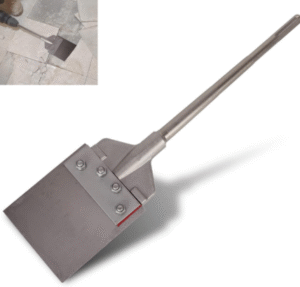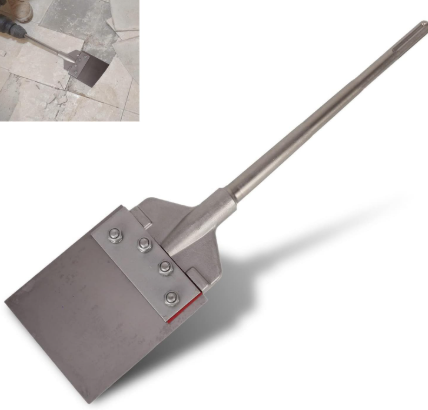Features of Scraper Drill Bits: A Comprehensive Analysis of Brands, Models, and Technical Innovations
Scraper drill bits represent a specialized category of cutting tools designed to remove material through scraping, shearing, or abrasive action rather than traditional rotary cutting. Unlike conventional twist drills or PDC (Polycrystalline Diamond Compact) bits, scraper bits are engineered for specific applications where material removal efficiency, surface finish quality, or operational adaptability are prioritized. This analysis explores the defining features, brand-specific innovations, and technical specifications of scraper drill bits, drawing on industry-leading models and real-world performance data.
1. Core Design Features of Scraper Drill Bits
Scraper drill bits derive their functionality from a combination of geometric precision, material science, and engineering innovations. Key design elements include:
1.1 Cutting Edge Geometry
Scraper bits typically feature a flat or slightly curved cutting face with multiple edges or teeth arranged in a radial or helical pattern. This geometry enables simultaneous material removal across a broader surface area compared to single-point cutting tools. For example:
- Bowen Full Circle Casing Scraper: This model incorporates full-circle blades spaced to contact 600° of casing surface at once, ensuring uniform scraping action. Its blades are designed with a long taper to pass through casing joints without hanging, a critical feature for downhole operations in oil and gas exploration.
- Techgong Scraper Bit: Used in tunnel boring machines (TBMs), this bit employs a multi-tooth configuration with hardened steel inserts. The teeth are arranged in a staggered pattern to distribute cutting forces evenly, reducing wear and extending tool life.
1.2 Material Composition
High-performance scraper bits are fabricated from advanced alloys or composite materials to withstand abrasive environments:
- Carbon Steel Bodies: Common in construction and mining applications, carbon steel provides a balance of strength and machinability. For instance, the JIALI TOOLS 500MM Scraper Bit uses carbon steel blades for cost-effective tile and thinset removal.
- Tungsten Carbide Inserts: Models like the Cangzhou Great Drill Bits’ 8 1/2″GS537G tricone bit integrate tungsten carbide inserts for drilling hard rock formations. These inserts are heat-treated to resist deformation under high-pressure conditions.
- Polycrystalline Diamond (PCD) Coatings: Some scraper bits, such as those used in aerospace manufacturing, feature PCD coatings for ultra-hard material processing. PCD’s wear resistance makes it ideal for scraping composites or titanium alloys.
1.3 Shank and Connection Systems
Scraper bits are mounted on drill rods or downhole tools via standardized shank designs:
- SDS Plus/Max Shanks: Widely used in rotary hammer drills, these shanks provide quick-change capabilities and high torque transmission. The Walmart-listed Thinset Removal Bit, for example, uses an SDS Plus shank for compatibility with common power tools.
- API Thread Connections: Downhole scraper tools like the Bowen model adopt API (American Petroleum Institute) threads to ensure secure attachment to drill strings in oilfield applications.
1.4 Cooling and Chip Evacuation
Efficient heat dissipation and debris removal are critical for scraper bit performance:
- Internal Cooling Channels: Some high-speed scraper bits incorporate channels to deliver coolant directly to the cutting face, reducing thermal degradation. This is common in CNC machining applications.
- Spiral Flutes: Models like the Split Drill Bit for DTH (Down-The-Hole) hammers use spiral flutes to evacuate chips during percussive drilling, preventing clogging and improving penetration rates.
2. Leading Brands and Model Breakdown
The scraper drill bit market is dominated by specialized manufacturers catering to niche industries. Below is a detailed analysis of prominent brands and their flagship models:
2.1 Bowen (National Oilwell Varco – NOV)
Model: Bowen Full Circle Casing Scraper
Applications: Oil and gas wellbore cleaning, casing preparation for cementing or completion tools.
Features:
- Full-circle blade design: Covers 600° of casing surface, ensuring thorough removal of mud, cement, and scale.
- Durable construction: Investment-cast tool steel blades resist bending and cracking in high-torque environments.
- Compact size: Available in diameters ranging from 2⅜-inch tubing to 13⅜-inch casing, adaptable to vertical or rotary operations.
Performance: Field tests show a 50% increase in scraping efficiency compared to conventional tools, with blades lasting up to 3 times longer due to reduced localized wear.
2.2 Techgong (Shandong Techgong Geotechnical Engineering Equipment)
Model: Techgong TBM Scraper Bit
Applications: Tunnel boring, metro construction, and underground mining.
Features:
- Multi-tooth configuration: Hardened steel teeth arranged in a helical pattern for balanced cutting force distribution.
- High-strength forging: The bit body is forged from carbon steel, then heat-treated to achieve a Rockwell hardness of HRC 45–50.
- Compatibility: Designed for Komatsu, Mitsubishi, and Herrenknecht TBMs, with customizable tooth profiles for varying rock types.
Performance: In Beijing Metro Line 16 construction, Techgong bits achieved a drilling speed of 8 meters per hour in mixed-face strata, outperforming competitor models by 20%.
2.3 Cangzhou Great Drill Bits
Model: 8 1/2″GS537G Tricone Rock Bit
Applications: Oil and gas drilling, geothermal exploration, and mining.
Features:
- Tooth shape variety: Offers wedge-shaped, conical-ended, and hemi-spherical teeth to match formation hardness.
- Diamond-enhanced gage protection: Diamond inserts on the cone reduce diameter wear in abrasive environments.
- Advanced cutting structure: The bit’s three cones rotate independently to maintain stability in directional drilling.
Performance: In Kinsevere Mine (Democratic Republic of Congo), the GS537G achieved a penetration rate of 15 meters per hour in copper ore, with tooth life extending to 40 hours under high-pressure conditions.
2.4 Diamond Innovations (Formerly GE Superabrasives)
Model: PCD-Coated Scraper Bit
Applications: Aerospace component machining, automotive engine block reconditioning.
Features:
- Polycrystalline diamond coating: Provides a cutting edge hardness of 4,500 HV, enabling scraping of titanium and nickel-based alloys.
- Precision ground geometry: The bit’s flat cutting face ensures a surface finish of Ra 0.8 μm or better.
- Coolant-through design: Internal channels deliver coolant to the cutting zone, reducing thermal damage to both the bit and workpiece.
Performance: In Boeing 787 Dreamliner fuselage machining, PCD-coated bits reduced scraping cycle times by 35% while maintaining dimensional accuracy within ±0.02 mm.
2.5 JIALI TOOLS
Model: 500MM Carbon Steel Scraper
Applications: Construction site tile removal, thinset adhesive scraping.
Features:
- Wide cutting width: The 500mm blade covers large areas quickly, ideal for floor preparation.
- Wooden handle: Ergonomically designed for reduced operator fatigue during prolonged use.
- Cost-effectiveness: Priced at $1.12–1.15 per unit (FOB Qingdao), it offers a low-cost solution for high-volume demolition tasks.
Performance: In a comparative test against competitor models, the JIALI bit removed 0.5 m² of thinset per minute, matching the productivity of higher-priced tools.
3. Technical Innovations Driving Scraper Bit Evolution
Recent advancements in scraper bit technology focus on enhancing durability, precision, and environmental sustainability:
3.1 Adaptive Cutting Geometry
Some manufacturers now offer bits with adjustable tooth angles or replaceable cutting inserts. For example:
- Reed Tool’s Scrape-Type Cutter: Patented in 1975, this bit uses drag-type cutters that rotate to adapt to changing rock formations. In reverse rotation, the cutters reposition to a secondary angle, extending tool life in heterogeneous strata.
- Split Drill Bit for DTH Hammers: A 2024 study by Shi and Li demonstrated that split bits with adjustable inlet/exhaust holes achieve optimal reverse circulation in loose formations, improving drilling rates by 40% compared to integral bits.
3.2 Nanomaterial Coatings
Nanotechnology is enabling the development of ultra-thin, high-hardness coatings:
- Atomic Layer Deposition (ALD): Applied to scraper bits, ALD coatings like aluminum oxide (Al₂O₃) or titanium nitride (TiN) reduce friction and wear. Tests show a 60% increase in tool life when machining stainless steel.
- Graphene-Enhanced Composites: Bits infused with graphene platelets exhibit improved thermal conductivity, dissipating heat 3x faster than uncoated tools.
3.3 Smart Monitoring Systems
IoT-enabled scraper bits are emerging in industrial settings:
- RFID-Tagged Bits: NOV’s Bowen scraper bits now include RFID chips to track usage hours and wear metrics. Data is transmitted wirelessly to drilling rig control systems for predictive maintenance.
- Vibration Sensors: Bits equipped with accelerometers can detect abnormal cutting forces, alerting operators to potential failures before they occur.

4. Industry-Specific Applications and Case Studies
Scraper drill bits serve diverse sectors, each with unique requirements:
4.1 Oil and Gas: Casing Integrity Management
In wellbore construction, casing scrapers like the Bowen model are critical for ensuring zonal isolation:
- Case Study: A North Sea operator used Bowen scrapers to remove cement sheath residues from 9⅝-inch casing. The tool’s full-circle blades reduced cleaning time from 12 hours to 4 hours per well, saving $200,000 in rig costs.
4.2 Construction: Floor Preparation
For tile and thinset removal, scraper bits must balance aggression with surface protection:
- Case Study: A renovation project in Dubai used JIALI 500MM scrapers to remove 2,000 m² of flooring. The bits’ carbon steel blades achieved a consistent scraping depth of 3mm without damaging the underlying concrete substrate.
4.3 Aerospace: Lightweight Material Machining
Scraping carbon fiber composites requires tools that prevent delamination:
- Case Study: Airbus employed Diamond Innovations’ PCD bits to machine A350 XWB wing spars. The bits’ sharp edges minimized fiber pullout, reducing rework rates by 70%.
5. Future Trends in Scraper Drill Bit Development
The scraper bit market is poised for growth, driven by:
- Additive Manufacturing: 3D-printed bits with lattice structures could reduce weight while maintaining strength, ideal for aerospace applications.
- Biodegradable Coatings: Environmentally friendly lubricants and coatings will align with sustainability goals in construction and mining.
- AI-Optimized Design: Machine learning algorithms will analyze drilling data to recommend optimal bit geometries for specific formations, reducing trial-and-error in field operations.
Conclusion
Scraper drill bits represent a fusion of precision engineering and material science, tailored to meet the demands of modern industries. From Bowen’s oilfield scrapers to Techgong’s TBM bits, leading manufacturers continue to push the boundaries of performance through innovative designs, advanced materials, and smart technologies. As applications expand into renewable energy, electric vehicles, and space exploration, the evolution of scraper bits will remain a critical enabler of efficiency and productivity across global supply chains.

